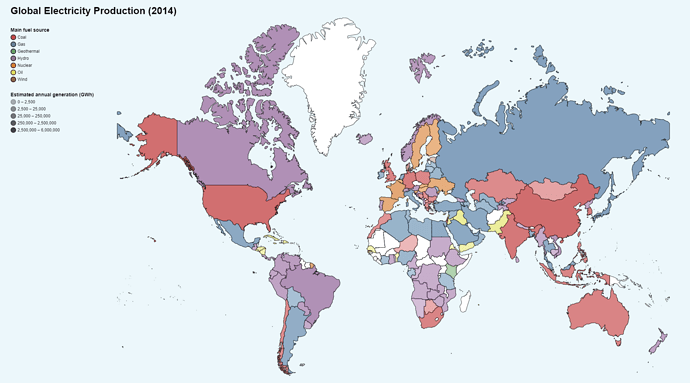Question:
I’m working on a visualisation that aims to find interesting patterns and trends in a world power plant data set, which contains all manner of statistics and production figures on the plants. As part of this, I have chosen to draw a choropleth map of the world in order to illustrate the most used power sources globally.
The problem is that I’m starting to doubt my use of visual encodings - specifically the hue and saturation of the countries. Here’s where I am so far:
Name of Tool: Altair
Dataset: Global Power Plant Database
Country: Worldwide
Year: 2014
Visual Mappings:
- The hue of a country represents its main fuel type; the fuel type it uses
to generate the most electricity. - The luminance of a country represents the amount of electricity it produces
across all fuel types. It is banded into five discrete values along an exponential scale. - Tooltips are used to offer detail-on-demand to the user, showing precise information
about a country’s electricity production. (so just imagine tooltips )
)
Output:
My issue is with the user’s ability to compare the quantitative values between countries, and especially those of different categories, as it seems to be difficult to determine saturation despite using a perceptually uniform colour set.
I’ve looked at some literature on the matter, and Ward, Grinstein, & Keim state that the combination of saturation and hue for encoding can only really provide a capacity of ~13 discrete values, where my visualisation incorporates 7 (hue) x 5 (saturation) = 30 values. Additionally, Munzner’s channel rankings for ordered attributes summarises that colour saturation is perceived fairly weakly.
I’m finding it difficult to choose a different encoding for the quantity, as others appear unsuited for use on a map (position, length, tilt, area). How could I improve this this and make comparisons easier? Should I change it at all?!
Hopefully someone can give me a different perspective on the issue. Thanks for reading!
[Ward, Grinstein, & Keim/Halsey & Chapanis] - Ward, Grinstein, Keim. (2015). Interactive Data Visualization: Foundations, Techniques, and Applications [p. 129]
[Munzner] - Munzner, T. (2015). Visualization Analysis and Design [pp. 102-103]
P.S. I couldn’t edit my post so I’ve had to repost the post ![]()
